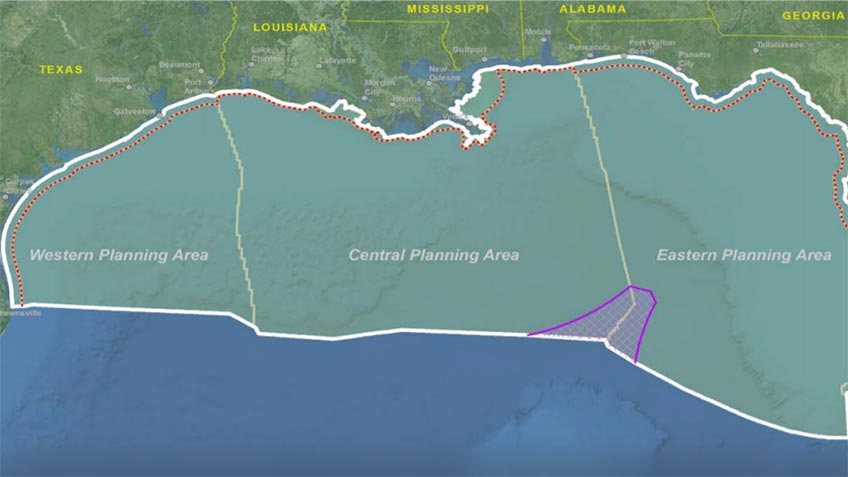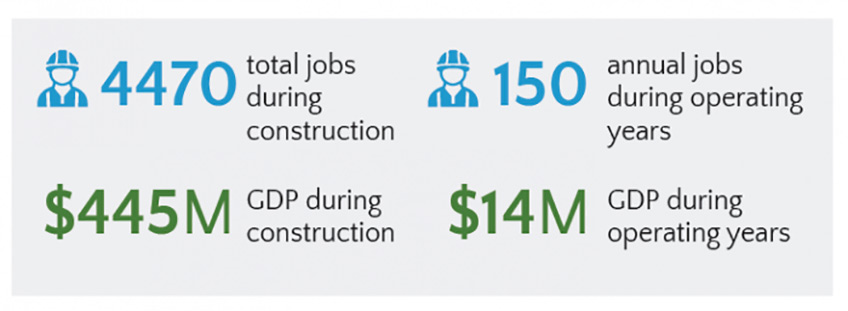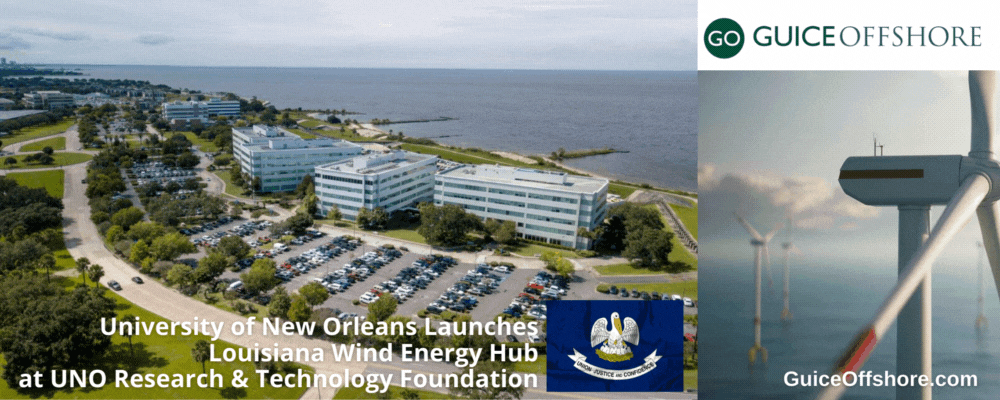With the goal of accelerating the growth of the state’s wind energy innovation ecosystem, supporting emerging companies, spurring the development of novel technologies and supplying trained professionals to the rapidly expanding renewable energy sector, the University of New Orleans, in partnership with the UNO Research & Technology Foundation, has announced the launch of the Louisiana Wind Energy Hub at UNO.
The hub will be located at The Beach at UNO, the University’s research and technology park, just a short drive across Lake Ponchartrain from Guice Offshore headquarters. The Beach, declared a Research Park District by the City of New Orleans, is a 30-acre site located on the shores of the historic Pontchartrain Beach. It is owned by the UNO Research & Technology Foundation, a 501 (c)3 created for the benefit of the University of New Orleans. The Foundation harnesses the power of a public-private partnership with the University, bringing out the best of academia, government, and entrepreneurial endeavors to maximize innovation and shared prosperity.
“I am very excited to be at the forefront in creating programming and an entrepreneurial environment to support the growth of wind energy in Louisiana and the Gulf of America,” said UNO President John Nicklow. “The demand for training, talent development, research and business development will grow over the next few years, and the University and The Beach at UNO are perfectly positioned to support and serve that industry.”
Louisiana’s 2022 climate action plan includes a goal of 5 gigawatts of offshore wind power generation by 2035, citing the availability of wind power as a potential energy resource from the Gulf of America and the state’s advantage as a strong offshore energy-producing state. The plan says the goal requires strategic collaboration across Louisiana state agencies and the federal government, transmission planning agencies, energy regulators, utilities and the private sector to help advance the development of offshore wind power generation. The hub will create an atmosphere of collaboration and innovation, leveraging regional and international industry partners.
“RWE applauds the University of New Orleans and its partners for the creation of the Louisiana Wind Energy Hub at UNO. Today’s announcement places UNO at the forefront of the next energy revolution for the State of Louisiana and the nation,” said Sam Eaton, executive vice president of offshore wind development, RWE Renewables Americas. “On the heels of the historic Louisiana Climate Action Plan, which includes a goal of 5GW of offshore wind, UNO’s investment in the Louisiana Wind Energy Hub will accelerate the state’s leadership in clean energy and offshore wind, built upon a deep legacy in ocean energy.”
RWE is one of the world’s leading companies in offshore wind, active in all stages of the industry from project conception and development to construction, as well as operation and maintenance. The company’s expertise has resulted in 18 wind farms in operation.
“This excellent initiative from the University of New Orleans has the potential to positively impact the transition of workforce to the emerging opportunity of offshore wind. Gulf Wind Technology values this contribution, and it aligns well with our own work on technology development,” said James Martin, CEO of Gulf Wind Technology, an Avondale, Louisiana-based company dedicated to improving the economic performance of operational wind farms and innovating in the field of rotors.
Here are some of the key activities that will take place at the Louisiana Wind Energy Hub at UNO, as well as other developments related to wind energy at UNO:
• Startup incubation support and services. The hub will provide business planning, regulatory guidance, grant development and fundraising support for startups in the wind energy field.
• Wind innovation programming. The hub will hold seminars, roundtables and networking events to connect stakeholders in the field and accelerate the offshore wind ecosystem.
• Seed technology commercialization grants. The hub will fund research at UNO to accelerate the development of translatable technologies and new intellectual property in the field of wind energy.
• UNO Wind Scholars Program. The hub will award scholarships to select UNO engineering students who take coursework relevant to offshore wind energy. The scholars will also get hands-on training through internships with an offshore wind engineering firm or developer.
• Offshore wind certificates. UNO’s Professional and Continuing Education (PaCE) division is offering certificates related to the offshore wind industry. Learners can now enroll in courses in Data Analytics, with real-world offshore wind energy data, and Offshore Wind Economics for Complete Beginners.
“The Louisiana Wind Energy Hub at UNO is the prime example of what can be developed through our invaluable partnership with the University and the private sector,” said Rebecca Conwell, president and CEO of the UNO Research and Technology Foundation. “We are thrilled to create an environment for students and entrepreneurs to become the leaders of offshore wind energy in Louisiana.”
Building and operating the infrastructure of the offshore wind energy sector will be worth $109 billion to businesses in their supply chain over the next 10 years, according to a report from the Special Initiative on Offshore Wind, a group affiliated with the University of Delaware.
“Every movement needs a home,” said Michael Hecht, president and CEO of Greater New Orleans, Inc. “With the establishment of the Louisiana Wind Energy Hub at UNO, the University of New Orleans is planting a flag in the steady breeze of progress, and declaring itself an important headquarters for the rapidly growing offshore wind movement in Louisiana.”
To learn more about the Louisiana Wind Energy Hub at UNO, visit www.lawindhub.com.
Professionals who are interested in collaborating with the hub may email info@lawindhub.com or call The Beach at UNO at (504) 280-2800.
Two NREL Studies Find Gulf of America Well Positioned for Offshore Wind Development
With its shallow, warm waters, smaller average wave heights, and close proximity to existing offshore oil and gas infrastructure, the Gulf of America presents many advantages for offshore wind. However, unique conditions in the Gulf of America introduce new technology challenges such as hurricane exposure, lower winds, and softer soils that will require offshore wind technology be adapted to not only survive these conditions, but also to demonstrate cost competitiveness in regional electric markets.
Announced on May 6, 2020, two studies conducted by NREL and funded by the Bureau of Ocean Energy Management (BOEM) yielded promising results for the future of offshore wind energy in this region.

The studies, which kicked off in April 2017, set out to assess the feasibility of various potential offshore energy resources in the Gulf of America and determine which technologies offer the most promise to meet the future energy needs for the five Gulf-bordering states of Texas, Louisiana, Mississippi, Alabama, and Florida. The results will inform federal and Gulf of America-bordering states’ strategic energy planning over the next decade.
The first study, “Offshore Renewable Energy Technologies in the Gulf of America,” analyzed different offshore renewable energy technologies, including offshore wind, wave, tidal, ocean current, ocean-based solar, ocean thermal, deep water source cooling, and hydrogen conversion and transport, to determine which are best suited for electric utility-scale development in the Gulf. Offshore wind was found to offer a technically feasible resource potential of 508 gigawatts—the largest of any of the technologies analyzed, and twice the energy currently consumed in the Gulf states.
In addition to identifying offshore wind as the leading technology for Gulf of America application, NREL further analyzed the economic feasibility of offshore wind both regionally and for selected sites. That analysis was the focus of the second study, “Offshore Wind in the U.S. Gulf of America: Regional Economic Modeling & Site-Specific Analyses.” In this study, NREL established selection criteria for hypothetical wind plant locations throughout the Gulf of America and recommended to BOEM six viable study areas: Port Isabel, Galveston, and Port Arthur in Texas; Pensacola and Panama City in Florida; and New Orleans in Louisiana. Of these sites, Port Isabel, Port Arthur, and Pensacola were selected jointly by BOEM and NREL for a more detailed cost analysis to represent possible future offshore sites in the Gulf of America. The study projected that costs will decline steadily over the next decade with some sites reaching the threshold of economic viability (market potential without subsidies) by 2030; but the assessment assumed that new technology adaptations for hurricanes and lower wind speeds would also be in place.
The analysis also indicated that a single offshore wind project could support approximately 4,470 jobs with $445 million in gross domestic product (GDP) during construction and an ongoing 150 jobs with $14 million GDP annually from operation and maintenance labor, materials, and services. These results were based on a 600-megawatt project at the Port Arthur reference site with a commercial operation date of 2030.

“As we seek to diversify the U.S. energy supply using ocean renewable resources, we are finding that the existing oil and gas industries in the Gulf are able to leverage their vast ocean-based capabilities to expand their businesses and capitalize on these new energy opportunities,” said NREL researcher and lead author Walt Musial.



